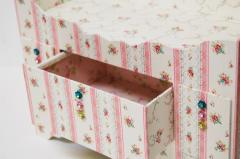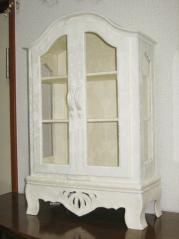About Cartonnage

Cartonnage is a form of craft that uses thick carton boards to create anything from small interior objects to large bookshelves. All throughout history, we have had different forms of cartonnage all around the world. It started from as early as the Ancient Egyptian times and was often created by recycling old objects to form something new, such as folding old newspapers to make a temporary trash box. Cartonnage as a craft with its elegant form was however found much later in France. Decorative paper and fabrics are used on the outer layer, creating a beautiful homemade piece of art. This is the type of cartonnage that is well known in the UK and was adopted and professionalized in Japan; however it is still not a wide-known style of art in the rest of the world.
現在見られるカルトナージュは、硬くプレスされた厚紙を切りだし、組立て、
表面に洗練された柄の布、紙を貼って仕上げる手作りのクラフトであり、
このような形態は、各国に存在する。多くは、古くなった箱のリメークである。
また、その存在は、古くは、古代エジプトまでさかのぼる。
エレガントなフォルムで知られるフランスのカルトナージュは、
かなり後に発見されたが、古代エジプトのカルトナージュは、
その姿が大きく異なる。

The first use of the word cartonnage started when funerary masks were found in Egypt. At the end of the Old Kingdom (ca. 2686 – 2181 BC) funerary masks were made of layers of moistened recycled papyrus or linen coated with stucco (lime plaster or gesso).1 They were then molded into shapes of the elites that were mummified. After they dried thoroughly, they were painted or gilded and used as the inner coffins of the mummies. It can be said that ancient Egyptian cartonnage is like papier-mâché in the contemporary world, which uses moistened paper; hence the word "carton," similar material as paper, was used to describe these masks.
始めてカルトナージュという単語が使われたのは、古代エジプトの葬式用マスクとしてである。お棺の外側、または、内側に、リサイクルペーパーや布を何層にも貼り付け、最終的に表面を塗装していた。この技術は、現代の張り子そのものである。
Cardboard, which is the main material for the craft of cartonnage, was first used in the silkworm industry in a small southern town in France called Valreas. Silkworm eggs were imported from China and Japan; however it was difficult to keep the silkworms alive on the long trips across Asia. They looked for a solution and discovered that cardboard boxes were perfect for keeping the silkworms last longer; therefore the production of these boxes dramatically increased when the trade of silk became widespread.2 Valreas is still the world’s top producers and exporters of cardboards.

カルトナージュ作品の土台となる素材は、現在では、硬くプレスされ、
密度の濃いカートンが使用されている。この起源を見てみると、
それは、現在の段ボールに近い素材で、フランスのヴァルレアスが発祥地だ。
当時、蚕の卵を中国や日本から輸入していたが、長い道中で、
蚕が痛むのを軽減させるのに使用したのが、紙製でありながら、
厚手で丈夫だったダンボール箱である。
ヴァルレアスは、絹糸産業において、現在でも、世界のトップに君臨している。
In France, cartonnage is commonly known as Le Cartonnage, art du cartonnage, or boite rectangulaire (rectangular box). It grew rapidly popular as pastime craft in the early 20th century amongst the wealthy ladies in Northern Europe. Teachers, such as Dominique Augagneur, use cardboard paper, or thick paper, as the base and covered them with decorative paper and fabric.3 Japan has taken its cartonnage from France, so a similar style of cartonnage can be found in Japan, with not only box shaped cartonnage, but photo frames, pencil holders and even large items such as desks.
フランスでのカルトナージュは、20世紀の初頭、富裕層の女性の間で、刺繍とともに、娯楽として親しまれていた時期から現在に至るまで、多くの国民が知る手作りの世界である。 日本では、2000年以前にも厚紙工芸として一部で楽しまれていたが、フランスの柄と色使いが人気で、名前をカルトナージュとしてから、急激に広まってきた。
In the UK, cartonnage is known more as a box making art to create decorations and accessories in the house. Quilts were often used for the colorful coverings with lessons held at quilting shops such as “Cotton Patch” from Birmingham, UK.4 Therefore small interiors cartonnage can be found more frequently than large furniture. Different types of materials are also used for the base of the work, such as thick carton boards, milk cartons and egg cartons at times. Heather Luke, an artist and author of UK’s popular craft book, “The Cartonnage Kit,” provides a perfect example of cartonnage found in the UK.5 In her book she shows how to make pencil holders and trays with as little equipment and techniques as possible so that anyone can enjoy this pastime. Another example of an UK artist is Lucy Bloom, an antiquary, who displays her collections at home and sells some at her family run shop called “Great Bedwyn Post Office Shop.”6 She has created her own cartonnage boxes as well, which shows how cartonnage really is a great match to vintage objects.
イギリスでは、カルトナージュの箱自体をインテリアとして飾る傾向が見受けられる。 パッチワークの布をカバーするなどした小さめの作品を多く見る事が出来る。
Unfortunately in the United States, cartonnage is still not a wide known craft amongst the general crowd. A wider-known and similar form of cartonnage that exist is cardboard box craft, where they reuse cardboard, milk cartons and egg cartons as cheap sources of materials, often to create children’s toys. In a smaller unknown market, we have cartonnage as a pastime that are sometimes called fabric-covered cartons.7 Generally the students are mid-age wives to elderly woman and are taught cartonnage as we know it in Japan, with thick carton paper making napkin holders and small boxes covered with decorative fabric or paper. Most of the times, the teachers are Japanese, such as Kepchan (her blog name) in San Diego; hence the similarities of cartonnage in the states to cartonnage in Japanese.8
残念な事に、アメリカでは、手作りを楽しむという意味での
カルトナージュの知名度は、高くありません。
そこかしこで販売されている綺麗な布や紙で覆われた収納としての大きな箱は、
見るからにカルトナージュ作品だが、それらは、
人件費の安価な国で大量生産された商品である。

Finally, here in Japan we have cartonnage as a similar style as France. They are enjoyed as pastimes, but simultaneously they have taken another form here. Miwa Murayama, a cartonnage teacher in Japan, has an atelier (art studio) in Yokohama. There, she is teaching people from all over Japan how to create cartonnage at its finest point. With her original techniques, she is showing people how to create cartonnage close to perfection and is taking it to another level of expertise. Therefore it is our mission to spread the word and the wonders of cartonnage as an elegant piece of art for pleasure and also as a professional piece of art.

最後に、ここ日本では、フランスからの影響が色濃く見える。
しかし、日本人というのは、料理の世界においても、ファッションの世界においても、
独自の感性で、それらを極める事に時間を惜しまない。
日本のカルトナージュ作家むらやま美和は、オリジナルの作製方法を多種多様に渡って研究し、
見た目の美しさだけではなく、丈夫さ、完成度の高さを
日本全国のたくさんの受講者に伝授している。
プロフェッショナルとしてのカルトナージュにかかわる人材育成を行っている。
Cartonnage with its many forms from funeral masks to the art of box making could be found in various different parts of the world. It can be found in France, where it originally came from, and it successfully reached the UK and Japan; however not much farther across the world yet. It is our duty to spread the world of cartonnage and how it can be displayed with proficiency in the art world. Then, cartonnage will truly be the next revolution in the world of art.
葬儀用マスクから、日常小物まで、エジプトとフランス発祥のカルトナージュは、海を渡り、日本、イギリス等に渡り、その名を広げてはいるが、真のハンドメイドクラフト界に名を馳せるには、これに携わる人々の弛まぬ努力が期待される。
Written by Aika Murayama (December 2012)
*日本語訳は、直訳を避け、全体の意味を重視させています。
1 Hayter, Simon. "Ancient Egypt - Cartonnage and Mummy Boards." Ancient Egypt - Cartonnage and Mummy Boards. EES, Manchester Ancient Egypt Society, and Egyptological Society of Ireland, 18 Mar. 2012. Web. 30 Oct. 2012. <http://www.ancient-egypt.co.uk/cartonnage/index.htm>.
2 Sarrazin, Chantal. "Valreas The World Cardboard Capital." Fantastic Provence with L'Occitane. L'Occitane En Provence, 8 Dec. 2011. Web. 2 Nov. 2012. <http://www.fantasticprovence.com/section/hand-made_r6/valreas-capitale-mondiale-du-cartonnage_a342/1>.
3 Augagneur, Dominique. "L'art Du Cartonnage." L'art Du Cartonnage. Augagneur Vincent, n.d. Web. 19 Nov. 2012. <http://www.artducartonnage.com/qui-suis-je-.html>.
4 David. "Patchwork and Quilting Shop - The Cotton Patch." Web log comment. Box Making Kits - The Art of Cartonnage. Blogger, 10 June 2008. Web. 04 Nov. 2012. <http://new.quiltingonline.co.uk/2008/06/box-making-kits-art-of-cartonnage.html>.
5 Amazon.com, Inc. Advertisement. Cartonnage Kit: Heather Luke. Amazon.com: Books, 4 May 1995. Web. 05 Nov. 2012. <http://www.amazon.com/Cartonnage-Kit-Heather-Luke/dp/0316913901>.
6 Bloom, Lucy. "Lucy Bloom: Cartonnage." Web log post. Lucy Bloom. Blogger, 21 May 2008. Web. 05 Nov. 2012. <http://lucybloom.blogspot.jp/2008/05/cartonnage.html>.
7 Kiat Beng, Chua. "FamilyTone." FamilyTone. Family Enrichment Society, Spring 2009. Web. 01 Nov. 2012. <http://www.familyes.org.sg/family_tone/09_2nd/feat2.html>.
8 Kepchan. "Kepchan's Workshop in Southern California." Rev. of Cartonnage Workshop. Web log post. Kepchan's Workshop in Southern California. Ameba, 22 Feb. 2011. Web. 01 Nov. 2012. <http://ameblo.jp/kepchan/entry-10809309490.html>.








